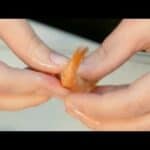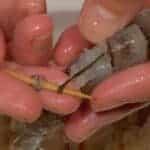It is Important to Devein Shrimp? We’ll find the answer together.
According to Coastal Living, shrimp is the most popular seafood in the United States, accounting for 25% of all seafood ingested. If you need any further proof, look no farther than Red Lobster’s annual Endless Shrimp festival. Those soft and tasty crustaceans can be cooked in a variety of ways, and if you’ve ever bought them raw, you’ll know that some preparation is required before cooking.
You may have heard of “deveining” shrimp in addition to removing the shell, which isn’t necessarily necessary. This requires removing the small black line running down the back of the shrimp with a knife. To begin with, this isn’t a vein, but rather the shrimp’s digestive tract, as if that makes it any less disgusting. And that dark substance is… shrimp excrement (via The Spruce Eats). Is it really necessary to go to the trouble of deveining each and every shrimp?
What Happens If You Don’t Devein Shrimp?
There are no negative consequences to not deveining shrimp. The only effect is that your seafood will not taste as it normally does. Instead, it will have an unappealing, slightly bitter flavor that may not satisfy your taste buds.
As a result, deveining the shrimp is not required because the chance of having any negative effects is low. Only the flavor of a well-washed shrimp will be missed.
Devein Shrimp: What Happens If You Eat Shrimps That Are Not Deveined?
The shrimp’s intestine, like that of everything else with an intestine, is home to a slew of germs that can be deadly. However, just because the seafood isn’t deveined doesn’t mean you can’t consume it.
As long as the shrimp is cooked properly, eating the vein will not harm you or make you sick. It’s because when shrimp are cooked, the germs in them die as a result of the heat.
However, because the germs in them are still active when not deveined and eaten raw, they may cause injury. Although most commercially trained shrimps have less grit in their digestive tracts, wild-caught shrimps are more vulnerable. In case you are looking for best shrimp deveiner, we have a list you can check.
Do You Devein the Top and Bottom of Shrimps?
Shrimps have two veins, white and black, that run through various sections of their bodies. The white vein is narrow and located on the bottom or underside of the vein. This white vein is so named because it denotes the shrimp’s blood is clear. As a result, the vein serves as its blood vessel. It is free of any dangerous substances, as well as grit, excrement, and bacteria. As a result, deveining this vein is not required.
So, if you’re wondering which portion of your shrimp to devein, it’s the bottom, which contains the digestive tract. A small knife or a skewer can be used to devein the shrimp.
The alimentary canal, on the other hand, is a primary vein that runs over its upper body. In essence, it is the shrimp’s digestive tract or intestine. This vein looks as a dark line beneath the shrimp, however it can also be brownish in hue rather than the usual black. It stores the waste, often known as poop, and acts as a filter for sand and grit. However, one thing is certain: no one wants to eat this because it could contain hazardous ingredients.
However, deveining this vein is not required because the risk of contracting a disease from eating it is extremely low and occurs solely when it is not cooked. The sole reason one might want to remove this section is to avoid biting on sand particles and to avoid an unappealing flavor
Was this helpful?
Hi there! I’m a food enthusiast and journalist, and I have a real passion for food that goes beyond the kitchen. I love my dream job and I’m lucky enough to be able to share my knowledge with readers of several large media outlets. My specialty is writing engaging food-related content, and I take pride in being able to connect with my audience. I’m known for my creativity in the kitchen, and I’m confident that I can be the perfect guide for anyone looking to take their culinary journey to the next level.








